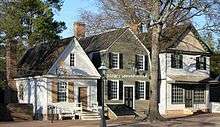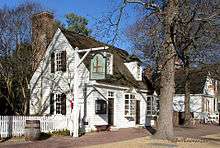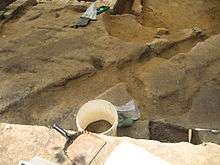John Holt (publisher)
John Holt was a colonial American newspaper publisher, printer, postmaster, and mayor of Williamsburg, Virginia, United States.
John Holt | |
|---|---|
| Born | 1721 Colonial Williamsburg |
| Died | January 30, 1784 |
| Resting place | St. Paul's Chapel, New York |
| Occupation | printer, postmaster |
| Known for | journalist in 3 colonies |
| Spouse(s) | Elizabeth Hunter (1727–1788)[1] |
Biography

Colonial Williamsburg reconstruction


Holt was born in 1721 (exact date unknown), at colonial Williamsburg in the state of Virginia.[2] He received his formal schooling and training as a merchant in the colonial town.[3] His brother-in-law, William Hunter, the "public printer", likely taught him the printing business there.[1]
Holt first became a store shop merchant at Duke of Gloucester street in colonial Williamsburg on lots numbers 49 and 50 in a "new store" he built about 1745, now known as "Holt's storehouse" on the north side of the street.[4] He also leased lot numbers 266, 267, 268 and 700 in colonial Williamsburg from Thomas Nelson during 1745 to 1753.[5] He had a house on lots 267 and 268 at the corner of Nicholson and Botetourt Streets, known today as the "Ravenscroft Site".[5]
Holt eventually became the mayor of colonial Williamsburg in November 1752 and served one term from 1752 to 1753.[5] He also held other public positions;[5] from 1748 to 1754 he was Justice of the Peace for York County, Virginia.[5]
In 1754 Holt had a negative cash flow problem at his Williamsburg storehouse, where he stocked general merchandise (i.e. groceries, dry goods, sewing items, china), so gave that business up.[4][6] He then became one of two deputy postmasters-general for the British American colonies. He worked with James Parker as a deputy partner.[1]
Holt was quite concerned about the postal system and gave extensive improvement suggestions to Samuel Adams on January 29, 1776, from the practical experience he gained as a deputy postmaster.[7] Part of the letter suggested that the Continental Congress should adequately supply whatever was necessary to provide reliable postal service.[8] Another suggestion Holt recommended was good delivery of all letters to and from soldiers on duty and that they might go free of postage.[9] Holt in the New York Journal or General Advertiser newspaper was the first person in New York to recommend a newsdealers' system for the delivery of newspapers instead of using post riders, which was dangerous.[10]
Holt played a role in the early history of the Connecticut Gazette. In 1755 Thomas Clap, President of Yale College, invited Benjamin Franklin to set up a printing press in New Haven, Connecticut. Benjamin Mecom, Clap's nephew, was to operate the press to publish the paper[1] Circumstances changed and Mecom declined to run the publication.[1] Franklin then sold the materials to James Parker, a well-known printer who began the Connecticut Gazette on April 12, 1755;[6] the first newspaper printed in the colony of Connecticut.[6]
Holt went to Parker in 1754 with a recommendation letter.[1][11] Parker gave him a job in the printing business helping publish the Gazette. The front page appeared with the co-partnership name of "James Parker and Company" on December 13, 1755.[6] Holt became the junior partner and resident editor conducting the printing business of the newspaper publication at New Haven.[6] He also ran the New Haven post office at the same time. Parker spent most of his time at his printing-house in New York City, so was often away from his New Haven businesses – which Holt managed.[1][12]
In 1760 Holt went to New York City to manage Parker's newspaper business there, the New-York Gazette and Weekly Post-Boy.[1] On July 31, 1760, the newspaper appeared with the title of "James Parker and Company".[6] Holt became James' junior partner in this newspaper,[6] as had previously happened in Connecticut.[13]
Both Holt and Parker controlled the post riders from New York City to Hartford, Connecticut. These post riders met the post riders from Boston.[1]
The partnership broke up on May 6, 1762.[1] Holt then became the general manager of the newspaper and changed the name to New-York Journal or General Advertiser.[3] He rented the publishing facilities from Parker on a four-year lease.[14] He leased the business from Parker until 1766, moving to "the lower End of Broad Street, opposite the Exchange" in May 1763.[10] Holt additionally then published books and other materials (i.e. pamphlets, handbills, broadsides) that were generally political.[6]
The publications Holt printed reflected his readers' struggle between the colonies and England.[6] He also printed laws and other court actions for the Provincial Congress of New York.[6] He also had a store that sold miscellaneous books on a variety of subjects including religion, freemasonry, economics, history, archaeology, poetry, and biographies. It also sold ink, paper, and other stationery supplies.[6]
Holt openly challenged the Stamp Act of 1765 while being the publisher of the New-York Gazette and Weekly Post-Boy. He was the favorite printer of the Sons of Liberty. Holt almost stopped the publication of this newspaper because of the heavy tax he would have to pay the English for stamped paper. The Sons of Liberty, with a threat of bodily harm, persuaded Holt to continue the newspaper in defiance of the tax.[15] Holt then continued the newspaper on unstamped paper and even published for meetings of groups against the Stamp Act. He added to the heading of his newspaper the words
The united voice of all his Majesty's free and loyal subjects in America – Liberty and property and no stamps.[6]
Holt had a close relationship with the Sons of Liberty, which helped him get printing equipment. Once, they bailed him out of debtor's jail with a fee of over £400.[6] The Sons of Liberty even subsidized him to publish the New-York Gazette and Weekly Post-Boy as a Whig newspaper.[16] He changed the name of the paper to New-York Gazette or General Advertiser in May 1766, where he printed his relationship with Parker.[10][14] Holt learned that Parker would not resume the New-York Gazette and Weekly Post-Boy, so he continued the newspaper using the title until October 9, 1766 (no. 1240).
On October 16 of the same year Holt changed the title to New-York Gazette or General Advertiser (no. 1241) and Parker then followed suit with the same number and printed his version of the New-York Gazette or General Advertiser.[10] Parker resumed his original newspaper that he had owned before leasing it to Holt.[14] Holt's newspaper (issue number 1756) discontinued in New York City on August 29, 1776. This was when the British troops were about to occupy New York City. Holt made a fast exit from the city to New Haven, Connecticut, just as the British occupied New York City, leaving behind all his printing equipment and materials, which the British destroyed.[10]
Holt went into the printing business in Norfolk, Virginia in 1770, in a shop supervised by his son John Hunter.[3] Holt ran the printing business under his son's name "John H. Holt and Company."[3] There he printed the Virginia Gazette (aka the Norfolk Intelligencer).[17]
Holt printed some unfavorable remarks about certain ancestors of Lord Dunmore and started a quarrel with him, the royal governor of the colony of Virginia.[10] Dunmore sent fifteen of King George's soldiers to Holt's printing shop and took all of the types and parts of the printing press.[18] In the presence of two to three hundred spectators the soldiers took these printing accessories and carried them back onto Dunmore's ship Eilbeck, offshore.[18] It was rumored that Dunmore wanted to print newspapers himself in vindication.[18] However, he had no ink and only parts of a press, so was unable to print.[18] The soldiers were looking for Holt's son to capture but couldn't find him as he was hiding and eventually escaped the territory.[18]
Holt then moved from Connecticut with his family in 1777 and went to Kingston, New York. There he became "public printer" for the colony of New York.[19] Holt revived his newspaper in Kingston on July 7, 1777, starting with issue number 1757. He printed it until October 13, 1777, ending with issue number 1771.[10] This was three days before the British burned down Kingston. He was only able to save of his personal property and about a sixth of his printing materials which included his account books, paper stock and two excellent font type sets.[10]
Holt again continued his newspaper on May 11, 1778, in Poughkeepsie, New York. In this town his newspaper was printed until November 6, 1780.[10] It then restarted on July 30, 1781, and stopped on January 6, 1782. This time the reason it stopped was for the need of printing laws of the Colony of New York. It then resumed again on November 22, 1783, being titled The Independent New-York Gazette.[20] Holt's newspaper was printed then for the rest of his life under this title and variations of that.
He criticized British "tyrannical designs" and taught the colonists how to resist British control.[14] Modern-day historian Edwin Emery labeled Holt "the most important Radical printer outside Boston" during the American Revolution.[2] Isaiah Thomas, founder of the American Antiquarian Society, described Holt as a "man of ardent feelings, and a high churchman, but a firm Whig, a good writer, and a warm advocate of the cause of his country."[2]
Newspaper collection fee problems
Holt had a problem collecting newspaper fees for some fifty years. An example was his attempt to collect subscription fees and advertisement fees from Jonathan Trumbull. Trumbull not only ordered the newspaper subscription on a yearly basis for himself, but ordered it for eleven others, and didn't pay for any of them.[21]
After Holt's death in 1784 his widow continued the Independent New-York Gazette newspaper until her death in 1788, when it passed to others and was published until March 8, 1800. Holt's widow also had a lawsuit against the State of New York for unpaid public printing done by Holt during the Revolutionary War.[10]
Family
Holt married Elizabeth Hunter, sister to renowned colonial Williamsburg publisher William Hunter, in 1749. According to biographer Layton Barnes Murphy they had two children:
- John Hunter Holt (b. July 1748), became publisher of the Virginia Gazette or the Norfolk Intelligencer.
- Elizabeth Holt (b. April 19, 1746), married Eleazer Oswald (editor of Philadelphia Independent Gazette).[22]
Death
Holt died in New York City on 30 January 1784 and was buried in the churchyard of St. Paul's Chapel in New York.[20]
Works
Major publications:
- New York Gazette and Weekly Post-Boy (1762–1766)
- New York Journal or General Advertiser (1766–1782)
- Independent New-York Gazette or the New York Journal Revived (1783–1784)
Printed examples of works contributed to Holt:
 The Report of Action of
The Report of Action of
Assault, Battery, Wounding
Oct 1764 New York Gazette or The Weekly Post-Boy
New York Gazette or The Weekly Post-Boy
Jul 24 1766 New York Gazette or The Weekly Post-Boy
New York Gazette or The Weekly Post-Boy
Aug 21 1766 New York Journal or General Advertiser
New York Journal or General Advertiser
Oct 16 1766 New York Journal or the General Advertiser
New York Journal or the General Advertiser
Apr 18 1776 New York Journal or General Advertiser
New York Journal or General Advertiser
Aug 25 1774 Practical Remarks on the treatment of wounds ...
Practical Remarks on the treatment of wounds ...
1775
Societies and churches
- Member of Sons of Liberty of New York[15]
- Member of Burton Parish Church of colonial Williamsburg [6]
See also
| Wikimedia Commons has media related to John Holt (publisher). |
References
- Charles Scribner's Sons 1932, p. 180.
- Featherston 1985, p. 285.
- Oswald 1965, p. 195.
- Colonial Williamsburg, inc 1972, p. 25.
- "History of Ravenscroft / John Holt". The Colonial Williamsburg Foundation. 2007. Retrieved 6 November 2013.
- Featherston 1985, p. 286.
- Paltsits 1920, pp. 13–15.
- Paltsits 1898, p. 50.
- Paltsits 1898, p. 51.
- Charles Scribner's Sons 1932, p. 181.
- The encyclopedia of colonial and revolutionary America 1996, p. 191.
- New York Public Library 1899, p. 49.
- North 1884, p. 17.
- Eisenstadt 2005, p. 727.
- Morgan 1953, p. 196.
- Emery 1978, p. 60.
- Paltsits 1920, p. 3.
- Holt, John (Oct 18, 1775). "Number 2443 (page 3)". Pennsylvania Gazette. John Holt.
- Frasca 2006, p. 161.
- Oswald 1965, p. 196.
- Williams 1999, p. 200.
- Ashley 1985, p. 285.
Bibliography
- Ashley, Perry J. (1985). American Newspaper Journalists, 1690–1872 / Dictionary of Literary Biography Vol. 43. Detroit, MI: Gale Research.CS1 maint: ref=harv (link)
- Colonial Williamsburg, inc (1972). Official Guidebook: Containing a Brief History of the City and Descriptions of More Than One Hundred Dwelling-houses, Shops & Publick Buildings. Williamsburg, Virginia: Colonial Williamsburg, Incorporated.CS1 maint: ref=harv (link)
- Dictionary of American Biography, volume IX (Hibben-Jarvis). New York: Charles Scribner's Sons. 1932.
- Eisenstadt, Peter R. (2005). The Encyclopedia of New York State. Syracuse, New York: Syracuse University Press. ISBN 081560808X.CS1 maint: ref=harv (link)
- Emery, Edwin (1978). The press and America: an interpretative history of the mass media. Prentice-Hall. ISBN 0136979793.CS1 maint: ref=harv (link)
- Featherston (Louisiana State University), James S. (1985). American Newspaper Journalists, 1690–1872 / Dictionary of Literary Biography Vol. 43. Detroit, MI: Gale Research.
- Frasca, Ralph (2006). Benjamin Franklin's Printing Network: Disseminating Virtue in Early America. University of Missouri Press. ISBN 0826264921.CS1 maint: ref=harv (link)
- "Holt, John 1721–84". The encyclopedia of colonial and revolutionary America. Da Capo Press. 1996. ISBN 0306806878.
- Morgan, Edmund Sears (1953). The Stamp Act Crisis: Prologue to Revolution. Institute of Early American History and Culture (Williamsburg, Va.): UNC Press Books. ISBN 0807899798.CS1 maint: ref=harv (link)
- New York Public Library (1899). The New York Genealogical and Biographical Record, Volumes 29–30. New York Genealogical and Biographical Society.CS1 maint: ref=harv (link)
- North, Simon Newton Dexter (1884). History and Present Condition of the Newspaper and Periodical Press of the United States: With a Catalogue of the Publications of the Census Year. U.S. Government Printing Office.CS1 maint: ref=harv (link)
- Oswald, John Clyde (1965). Printing in the Americas, Volume 1. Kennikat Press.CS1 maint: ref=harv (link)
- Paltsits, Victor Hugo (1898). The New York Genealogical and Biographical Record, Volumes 29–30. New York Genealogical and Biographical Society.CS1 maint: ref=harv (link)
- Paltsits, Victor Hugo (1920). John Holt, printer and postmaster; some facts and documents relating to his career. New York, Public library.CS1 maint: ref=harv (link)
- Williams, Julie Hedgepeth (1999). The Significance of the Printed Word in Early America: Colonists' Thoughts on the Role of the Press. Greenwood Publishing Group.CS1 maint: ref=harv (link)